-
Countries
-
Data and Analysis
-
Special Focus
-
Crisis Responses
Internal displacement
Domain host
displacement.iom.int
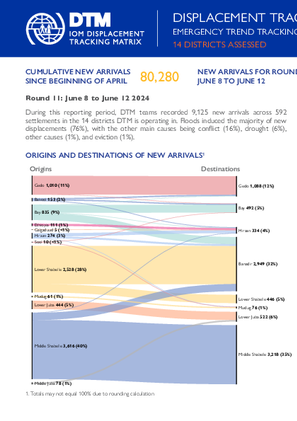
Contact
DTM Somalia, IOMSomaliaDTM@iom.int
Language
English
Location
Somalia
Period Covered
Jun 08 2024
Jun 12 2024
Activity
- Mobility Tracking
- Baseline Assessment
This latest round of Emergency Trends Tracking was initiated in April 2024 to monitor displacements movements during the Gu rainy season. Districts covered in this round include Afgooye, Afmadow, Baardheere, Baidoa, Balcad, Belet Weyne, Dayniile, Gaalkacyo, Hodan, Jamaame, Jowhar, Kahda, Kismaayo, Luuq. ETT is a crisis-based tool that tracks sudden displacement triggered by specific events or emerging crises.
The objective of ETT is to help prioritize humanitarian response and to enable partners to deliver rapid assistance. Based on previous shock induced displacement patterns, the humanitarian community expects that people will continue to move toward urban areas in search of humanitarian services. Consequently, the ETT coverage focuses on the main urban centers and surrounding villages for each assessed district. The data is collected through Key Informant Interviews (KIIs) at the location level, from Sunday to Wednesday every week. It includes information on new arrivals, numbers and demographic of IDPs, reasons for displacement, intentions, humanitarian assistance and priority needs among others.
The ETT tool also adapts to regional contexts: because of the very high number of IDP sites in Khada and Daynile districts in Banadir region and in Baidoa district in Bay region, a zonal approach has been adopted for these areas. Each week, KIIs are first conducted at the zone level to indicate to the field teams which locations have received the most new arrivals and which need to be assessed. To facilitate the joint analysis of the CCCM (Camp Coordination and Camp Management) Cluster’s New Arrivals Tracker (NAT) and ETT data, the assistance and needs indicators are identical in both tools.
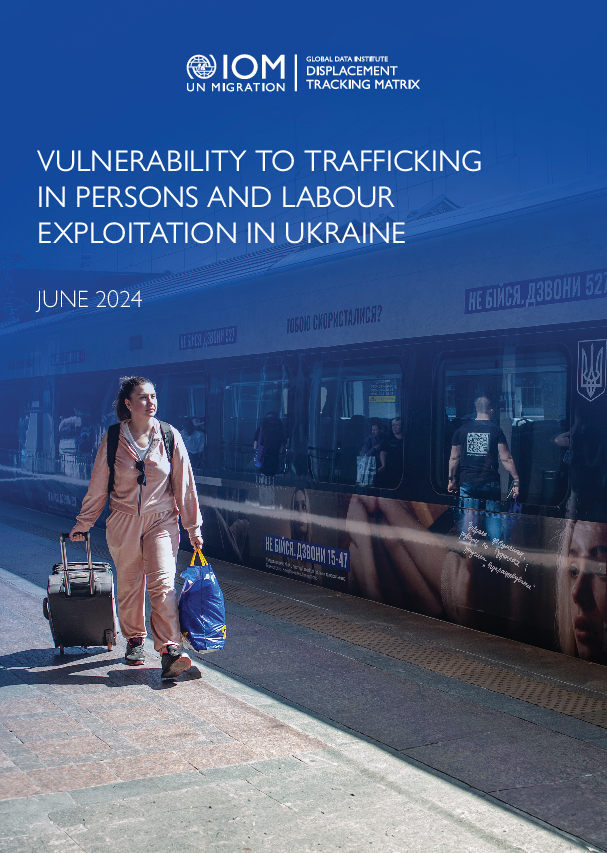
Contact
DTM Ukraine, dtmukraine@iom.int
Language
English
Location
Ukraine
Period Covered
Mar 10 2024
Apr 11 2024
Activity
- Other
The full-scale invasion of Ukraine by the Russian Federation in February 2022 has triggered mass displacement and a humanitarian crisis, heightening the population’s vulnerability to protection risks, including trafficking in persons, particularly among displaced and conflict-affected communities. Despite comprehensive responses aimed at mitigating an expected surge in trafficking, significant risks persist as coping strategies are increasingly strained. Anti-trafficking actors across Ukraine have been vocal about the risks of trafficking, based on pre-existing trafficking trends within the country and region, knowledge of trafficking in emergencies from previous crises, and the specificities of this crisis.
This report examines protection risks related to the war in Ukraine, focusing on labour exploitation, travel-related deception, and the awareness and accessibility of support systems. Utilizing data from the IOM General Population Survey, the report aims to support evidence-based programming, policy-making, advocacy, and further research.

Contact
IOMASTANA@iom.int
Language
English
Location
Kazakhstan
Period Covered
Jan 01 2024
Mar 31 2024
Activity
- Survey
- Flow Monitoring
- Mobility Tracking
- Baseline Assessment
The quarterly report is developed by combining secondary data obtained from different sources, including government agencies, international organizations, non-profit entities, and other types of organizations. More specifically, the report for the first quarter of 2024 was derived from data from the Ministry of Internal Affairs, Bureau of National Statistics, and Border Service of Kazakhstan. The data was compiled through a combination of published sources and direct requests to the partners and government agencies.

Contact
DTMUkraine@iom.int
Language
English
Location
Ukraine
Period Covered
Mar 10 2024
Apr 11 2024
Activity
- Survey
Between 10 March and 11 April 2024, the International Organization for Migration (IOM) conducted Round 16 of the General Population Survey (GPS), a highly representative assessment of internal displacement in Ukraine. The data presented in this report was commissioned by the International Organization for Migration (IOM) and collected by 59 enumerators employed by Multicultural Insights through screener phone-based interviews with 20,000 randomly selected respondents and follow-up interviews with 1,428 IDPs, 1,639 returnees, and 2,266 residents, using the computer-assisted telephone interview (CATI) method, and a random digit dial (RDD) approach.
This report provides the main findings from Round 16 of the GPS, including detailed insights into population figures, mobility intentions, demographic profiles, household composition and vulnerabilities, and needs of the returnee population, to facilitate evidence-based decision-making on strategic, technical, and programmatic aspects of the response and recovery efforts in Ukraine.
Contact
DTMSudan@iom.int
Location
Sudan
Activity
- Mobility Tracking
- Baseline Assessment
Period Covered
May 09 2024 -Jun 11 2024
- An estimated total of 10,095,054 IDPs were displaced across 8,239 locations, in 183 localities in all 18 states in Sudan.
- An estimated 7,262,187 individuals were displaced internally within Sudan since 15 April 2023.
- An estimated 26 per cent of IDPs who were initially displaced prior to the onset of current conflict experienced secondary displacement since 15 April 2023.
- Approximately 2,170,592 individuals crossed borders into neighbouring countries since 15 April 2023.
- The top states of origin among IDPs were Khartoum (36%), South Darfur (21%), and North Darfur (12%).
- The states hosting the most IDPs were South Darfur (18%), North Darfur (13%) and Central Darfur (9%).
- Over half (55%) of IDPs were reportedly children under the age of 18-years-old.
A more detailed version of this dataset is available, to get access kindly click on the 'Request Access' button
Population Groups
IDPs
Survey Methodology
Unit of Analysis Or Observation
Admin Area 2
Admin Area 3
Type of Survey or Assessment
Key Informant
Keywords
Geographical Scope
Administrative boundaries with available data
The current dataset covers the following administrative boundaries
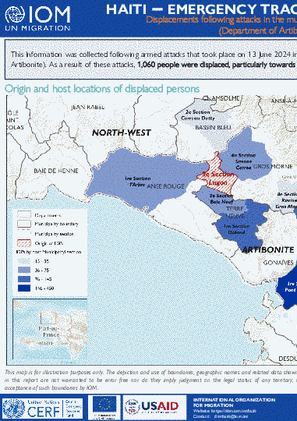
Contact
dtmhaiti@iom.int
Language
English
Location
Haiti
Period Covered
Jun 14 2024
Jun 17 2024
Activity
- Mobility Tracking
- Event Tracking
This Information was collected following armed attacks that took place on 13 June 2024 in the municipality section of Lagon located in the municipality of Terre Neuve (Department of Artibonite). As a result of these attacks, 1,060 people were displaced, particularly towards the municipality of Gonaïves (68%). All of these people took refuge with host families.
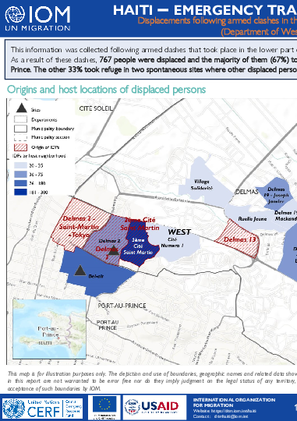
Contact
dtmhaiti@iom.int
Language
English
Location
Haiti
Period Covered
Jun 14 2024
Jun 15 2024
Activity
- Mobility Tracking
- Event Tracking
This information was collected following armed clashes that took place in the lower part of the municipality of Delmas in the Metropolitan Area of Port-au-Prince, since 13 June 2024.
As a result of these clashes, 767 people were displaced and the majority of them (67%) took refuge with host families in neighborhoods in the same municipality and in that of Port-au-Prince. The other 33% took refuge in two spontaneous sites where other displaced persons have been residing for several months. Updates will be published by DTM according to the
evolution of displacements.
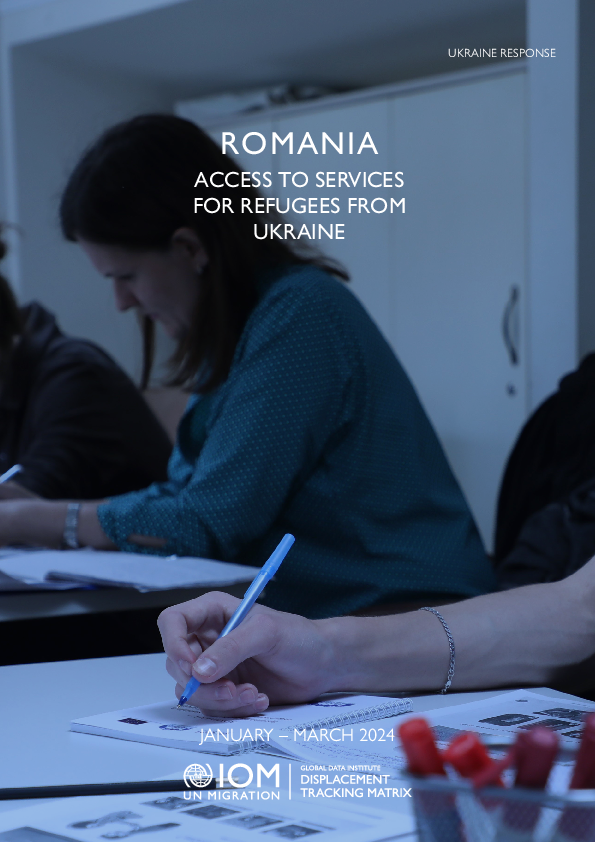
Contact
DTM Europe, DTMMediterranean@iom.int
Language
English
Location
Romania
Period Covered
Jan 01 2024
Mar 31 2024
Activity
- Survey
- Flow Monitoring
IOM’s Displacement Tracking Matrix (DTM) collected data on the needs, intentions, and integration challenges of refugees as part of the Surveys with Refugees in the Ukraine Response Region exercise. From January to March 2024 (Q1), DTM interviewed a total of 437 individuals in Romania, all of whom were Ukrainian except one. This report presents the findings of surveys with 436 adult Ukrainian nationals, including access to services that facilitate integration, and need and assistance.
Key findings:
- Migration status
- 93% EU Temporary protection status
- 7% Other Active population:
- Household (HH) composition
- At least 2 adults and 1 child – 38%
- A single adult and at least 1 child – 21%
- Alone – 21%
- At least two adults and no children – 19%
- Other – 1%
- Children
- 65% - HH with children
- 68 % - children aged between 5 and 17 years old
- 32% - infants aged between 0 and 4 years old
- Needs
- Financial support (73%)
- Sanitary products (56%)
- Food supply (53%)
- Health services (53%)
- Employment (31%)
- Obstacles in accessing healthcare
- Language barrier 43%
- None 38%
- Cost 29%
- Long queues 17%
- Unavailable Services 8%
- Ease of visiting a doctor
- Very difficult 8%
- Somewhat difficult 31%
- Neither easy, nor difficult 30%
- Somewhat easy 13%
- Very easy 1%
- Unknown 17%

Contact
DTM Support — iomdrcdtm@iom.int
Language
French
Location
Democratic Republic of the Congo
Period Covered
Jun 04 2024
Jun 09 2024
Activity
- Mobility Tracking
- Event Tracking
Depuis le 27 mai 2024, des violents combats entre les FARDC et le groupe M23 et leurs alliés dans le territoire de Rutshuru se sont rapprochés de l’agglomération de Kanyabayonga, situé à cheval des territoires de Lubero et Rutshuru. Des populations hôtes de villages de la zone de santé de Kibirizi en groupement de Kanyabayonga (villages de Lusuli Bulindi, Lusogha, Burindule, et Butalongola) dans le territoire de Rutshuru et ceux des communes rurales de Kanyabayonga et Bulotwa (territoire de Lubero) ainsi que les personnes déplacées déjà reçues dans les zones affectées ont été contraint de se déplacer vers les zones considérées comme relativement sécure. Ces zones de refuge se trouvent territoire de Lubero dans les zones de santé de Kayna, Alimbongo, et Butembo; et dans le territoire de Walikale dans la zone de santé de Pinga (groupement d’Ikobo). Ces ménages déplacés ont été reçus en majorité dans les familles d’accueil ainsi que dans les centres collectifs. Les besoins humanitaires sont considérables dans l'ensemble des zones touchées et risquent de s'aggraver encore sans une action urgente.
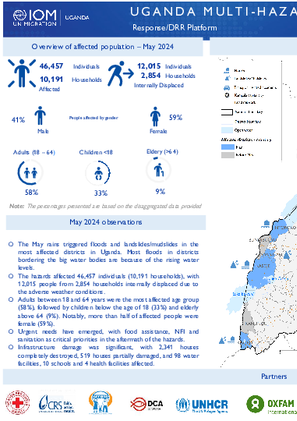
Contact
DTM Uganda, dtmuganda@iom.int
Language
English
Location
Uganda
Period Covered
May 01 2024
May 31 2024
Activity
- Mobility Tracking
The May rains triggered floods and landslides/mudslides in the most affected districts in Uganda. Most floods in districts bordering the big water bodies are because of the rising water levels. The hazards affected 46,457 individuals (10,191 households), with 12,015 people from 2,854 households internally displaced due to the adverse weather conditions. Adults between 18 and 64 years were the most affected age group (58%), followed by children below the age of 18 (33%) and elderly above 64 (9%). Notably, more than half of affected people were female (59%). Urgent needs have emerged, with food assistance, NFI and sanitation as critical priorities in the aftermath of the hazards.
Infrastructure damage was significant, with 2,341 houses completely destroyed, 519 houses partially damaged, and 98 water facilities, 10 schools and 4 health facilities affected.
It is important to note that the information presented in the dashboard is derived solely from the represented districts, and no other major hazard events were reported from other districts.
Pagination
- Previous page
- Page 71
- Next page
